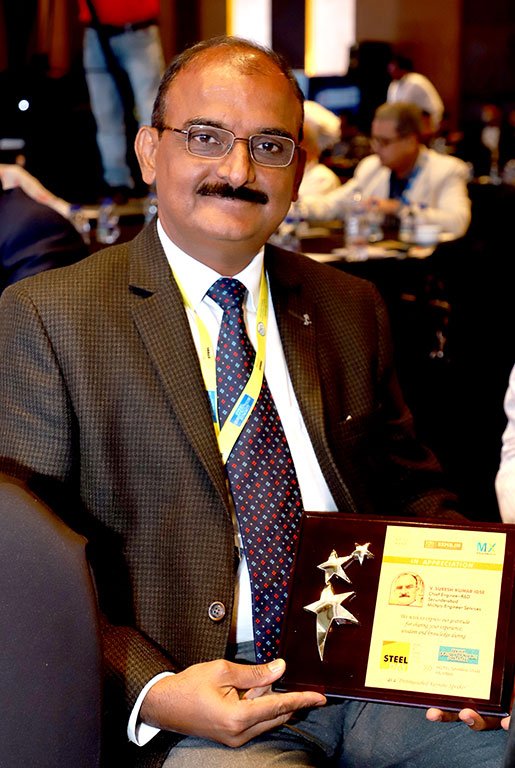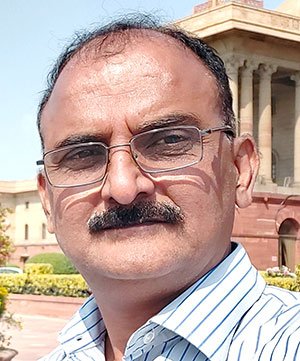He has spent over half his life to serve our country in the Military Engineering Services with a magnanimous experience in structural engineering for 34 years & counting… He sees Steel as the future of our construction industry…
Here’s V Suresh Kumar, Chief Engineer R&D Secunderabad, Military Engineering Services, sharing his wisdom with us.
Q. How has been your journey with steel?
A. I have been working in the field of structural engineering since 1988. I have seen the period of rolled steel sections and cold formed sections and have gained experience over the years, to arrive at the present-day, high strength steel plated sections. I think the growth and developments in the steel construction industry in the last 10 years have been phenomenal, both, in terms of volume as well in technology. Having said that, I think the fluctuation in prices and non-implementation of standards across the board is posing serious challenges today.
There has to be a regular technical collaboration between the industry and the committee on standards. The industry should contribute to revision and updates of the standards by giving regular inputs. For this purpose, the industry must form a permanent body with technical representatives from all major players which will work as an advisory body to the BIS.
The fluctuation in price of steel in our country is more of a political issue rather than a technical issue. Government regulatory bodies have to ensure a better price regulation mechanism for building materials and strict implementation of standards. This will result in more BIS certified firms available in the field to increase the competition. However, it is seen that the manufacturers soon forma cartel which then dictate the market prices. This unfair practice can be regulated only by proper action at the government level. The government should ensure a healthy field of working for the construction industry which is the actual nation builder.


Q. Please share your views on Steel vis-à-vis Concrete Buildings?
A. While concrete is a versatile material of construction, the extreme sizes of modern structures, difficulties in quality control at site and project completion time has made steel a more acceptable material in the recent past. Additionally, the tremendous development in roadway infrastructure, availability of transport and logistics, modern handling equipment has made it possible for the steel construction industry to be viable.
With more and more high-rise buildings coming up, it is inevitable for the industry to move on to steel frames because of the inherent problems of concrete related with creep insufficient E-value, which restricts the ductility of the frames to a large extent. Composite or pure steel frames needs to be adopted in all buildings more than 30 meters in height, to make the designs more viable. The large spans which are possible in steel frames will result in more flexible space utilization within. Steel with its inherent ductility properties is a better choice under dynamic loads including earthquake and blast loads. This will alleviate a major concern of safety and security in strategic and key infra structure.
If designed with caution, steel structure can cater for future deviations and alterations more easily compared to steel structure. Instead of the culture of demolition and reconstruction prevalent in industry now, we can go for reorganizing the existing structure. This require only a design strategy with a long vision, which is possible in steel structures.
Q. Which are the grey areas that need to be addressed by the industry to advocate structural steel construction in our country?
A. One of the major grey areas of the construction industry is the lack of innovation in the recent past. I always felt that we have not moved ahead in the last 5-6 years beyond PEB structural elements. Not much research efforts are being made to make steel more acceptable with newer technologies. For example, steel is yet to make an impact in the residential housing sector as of today. We are still stuck up with masonry walls and concrete frames. We must look in for multiple options like composite construction in residential sector with steel structural frames and prefabricated dry wall systems in high rise apartments.
Another sluggish area of concern is the slow pace of revising standards in our country and lack of a centralized agency for monitoring the implementation of these standards. Owing to this, firms which are following the standards are falling back in competition with firms who cut corners by flouting the norms of safety and quality.
There are also a lot of gaps in coordination between designers, fabricators and/or contractors. Rules do not stipulate the inspection by designers to certify “as designed” aspect of construction. This would help the industry to gain more credibility among end users.
One more grey area in our country is the lack of recycling methods. Old structures and steel retrieved is not being used successfully.


Q. Which has been you best work so far involving structural steel?
A. In the defense sector, we have made a remarkable number of large span hangars that helps the armed forces to fulfill the defense needs of the country within a time frame. The technology of PEB has helped in this aspect tremendously. We have gained considerable time in infra modernization by this.
Q. What are the challenges faced while working on steel for various projects?
A. The biggest challenge that I have faced, was to ensure that the PEB manufacturer is following all the design aspects correctly. Many a times it is seen that at least some of the manufacturers are cutting the corners by compromising a provision or two in the design codes. The agencies vetting the design were also overlooking these omissions. It is required for the industry to identify the right designers and provide some sort of certification for them.
Q. What is your relationship with the defense sector of our country and what inspired you to venture into Military Engineering Services?
A. I joined the defense sector as an Engineer in Military Engineer Services (MES), when I was selected through Engineering services Exam. During the process, I had selected MES since it is the biggest agency in infrastructure development in the government sector. Having taken the decision at the time, I did not have any fair idea of the nature of works and challenges I would face thereof.
During these 35 odd years of service with MES, I have understood that it is the only engineering organization in the country which can give you such a varied experience in the construction industry. I could work with all kinds of infrastructure projects related to defense such as technical buildings, large span storage facilities, air craft hangars, explosive storage and handling facilities, defense laboratory facilities, runways and roads, dock facilities, training facilities for men and machines, firing ranges, huge electrical and air conditioning infrastructure and so on.
To work with design and construction of so many different projects could be a dream for a structural engineer in his life time. Adding to these challenges in the geographical diversity of the stations; I have worked in project design in all earth quake zones, all climatic conditions of exposure from snow bound regions, deserts and highly corrosive costal belts. At times we have worked with more than seven to eight subject experts and consultants to plan a single project. The knowledge base MES is having is unique because of these reasons.
Q. What benefits can steel offer in defense projects?
A. As I have already mentioned, as most the defense infra projects are time bound, steel structures, especially PEB structures have helped in completing the projects well in time. This has in turn helped in induction of modern weapon systems and facilities in time as well as in establishing indigenization of production facilities within the country. Secondly the issue of quality control at site in massive infra projects have been solved to a large extent due to use of factory fabricated components, especially in large span hangars.
There is a large scope for steel construction in defense infra projects. I think the industry should develop designs for explosive storage buildings with steel as the major component of construction because blast resistant structures are an important component of defense infrastructure. Steel structures can also be effectively inducted into multistoried living accommodation. MES is already going for 60+ storied married accommodation projects in metros. Presently I feel that there is a large gap between defense infra projects and major infra development companies.
Q. What is your mantra for success?
A. The basic mantra I follow is to always keep your long terms goals in sight and never compromise in quality and credibility for short term gains. We have to remember that failure of a few contractors may be termed as a failure of technology by the masses; it will be suicidal. Every player has to instill self-standards for the industry to grow.
Q. What message would you like to give our readers?
A. With my experience in the field of structural design and construction, I would say that do not despise any modern technology without verification. Modernization and changes make any technology vibrant and sustainable. Steel as a material has got future but your right actions today, will give you a place in that future; otherwise, you will end up as a spectator.
I myself would like to work with designers and research hands to take these dreams forward. I also have very noble intentions to take the dreams and requirements of the industry to the academicians and engineering students. The knowledge gap between academic environment and industry is very large. I have offered my services for dialogues on technical matters with students in various institutes. This is a job I want to do voluntarily. I hope all dreams will come true.







